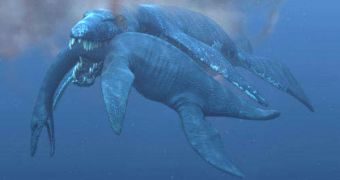The remote Arctic archipelago of Svalbard has been home to one of the most disturbing archaeological finds in years, and namely that of a super-sized marine hunter, dubbed Predator X. And scientists haven't called it super-sized for nothing, as its skull is about twice as large as that of a Tyrannosaurus Rex. The beast weighed in at about 45 tonnes, which is pretty much for a single animal. Over millions of years, evolution has suppressed such large creatures from existence, but this one really takes the cake.
The 15-meter (47-foot)-long creature lived more than 147 million years ago and is a true remnant of a defunct era, when nature and evolution didn't yet learn to limit the growth of animals to a sustainable level.
Thus, this ungodly Predator X could bite its pray with about 15,000 kilograms (33,000 pounds) of force, which means that it's mouth, jaws and muscles were four times stronger than those of T. Rex. It goes without saying that the beast ruled the Jurassic seas unchallenged until its disappearance.
University of Oslo Natural History Museum professor Jorn Hurum led the June 2008 expedition to Svalbard, where the find was made. “Its anatomy, physiology and hunting strategy all point to it being the ultimate predator – the most dangerous creature to patrol the Earth's oceans. 'Predator X,' the marine reptile is a new species of pliosaur, an apex predator that patrolled the Jurassic oceans 147 million years ago. The skull, 'the jewel in the crown for paleontologists,' was excavated from the Arctic permafrost during a 2-week field expedition,” a press release from the museum reads.
“The condyle we have found measures 6 inches in diameter, the largest condyle of any known pliosaur species. By comparison, the condyle of a T-Rex measures just 3 inches across – Predator X's skull was at least double the size,” Hurum says when talking about the bone that connects the spinal cord to the base of the skull. This biological trait can be found in most mammals and reptiles.
The animal, of which a total of 20,000 skeletal fragments have been found, used four flippers to propel itself through the waters of the Arctic. “By calculating the hydrodynamic properties of the flippers using a wind tunnel, Frank and Laurens were able to calculate that Predator X could generate enough power from only 2 flippers to move through the water – the question was, why did it have four?” the press release continues.
“When using four flippers, Predator X may have been able to accelerate faster, at the cost of high energy consumption. These results suggest that Predator X could have used its front 2 flippers for cruising, but employed all four flippers when it hunted to accelerate towards its unsuspecting prey,” the scientists believe. A full report on the pliosaurus is to be published later this year.

 14 DAY TRIAL //
14 DAY TRIAL //